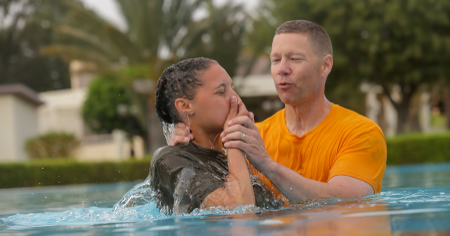
When discussing the topic of baptism, it is necessary to discuss mode, subject and purpose in order to have a scriptural understanding of the matter. Let’s consider the following:
MODE
By mode, we mean how the act of baptism in water is accomplished. It may seem obvious, but traditions of men have clouded the matter.
The definition of the word indicates an immersion. Consider the conversion of the Eunuch in Acts 8:38-39. The inspired record indicates that Philip and the Eunuch “went down into the water,” he baptized (immersed) him, and then they “came up out of the water.”
We are told that John the Baptist did his work of baptizing (immersing) in “Aenon near Salim, because there was much water there” (John 3:23).
The very first recorded example of another mode, (i.e.—sprinkling or pouring in lieu of immersion), took place in 253 AD. The historian Eusebius wrote about a man who believed immersion was necessary, but was on his death bed. He could not leave his bed, so water was poured all about him as a substitute.
There is no scriptural record, and therefore no scriptural authority, for any mode other than immersion when considering the command to be baptized. In fact, it was not until 1311 AD that the Catholic church officially accepted sprinkling and pouring as substitutes for immersion. Church tradition and men’s opinions are no substitute for God’s word. The only proper mode for Bible baptism is the immersion of the body in water.
SUBJECT
Only believers of the gospel are acceptable subjects for baptism. Jesus said in Mark 16:15-16, “Go into all the world and preach the gospel to every creature. He who believes and is baptized will be saved; but he who does not believe will be condemned.” As baptism is to be done by the authority of Christ (cf. Acts 2:38), one who does not accept the Lordship of Jesus can’t be baptized. They can be dunked in water, but not baptized.
Infants and small children, though often “baptized” in various denominations, are not scriptural candidates for baptism. As they are not yet accountable for their actions, they are not guilty of sin. It is the one guilty of sin who has need of, and benefits from, baptism (cf. Matthew 18:3-5).
PURPOSE
The final question is easily answered by scripture. Why are we to be baptized? Consider the following:
- One who believes and is baptized, “will be saved” (Mark 16:16).
- Baptism is, “for the remission of sins” (Acts 2:38).
- Baptism is to, “wash away your sins” (Acts 22:16).
- One who is baptized rises to “walk in newness of life” (Romans 6:4).
- Baptism puts one “into Christ”, and causes one to “put on Christ” (Galatians 3:27).
- Baptism “saves us” (1 Peter 3:21).
CONCLUSION
The immersion in water, in the name of the Lord Jesus Christ, brings one who believes the gospel of Christ into contact with His shed blood. At that point the believer’s sins are washed away, and he is reconciled to God. He rises to walk in the new life of a child of God. He is saved!
To see The Patternists Page on Facebook, click here, and Like!




